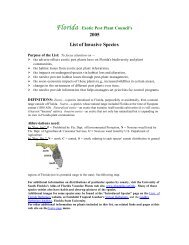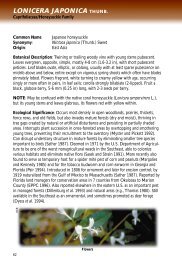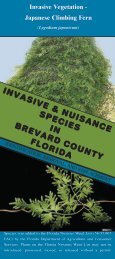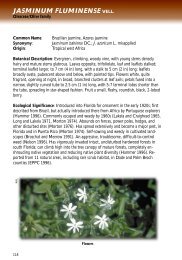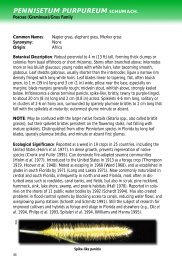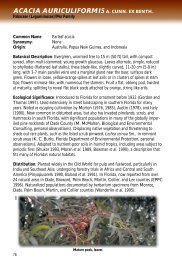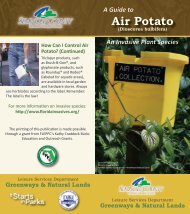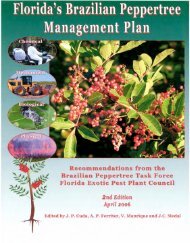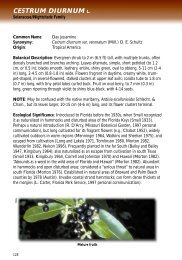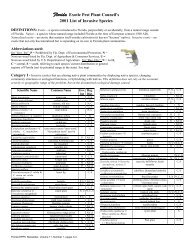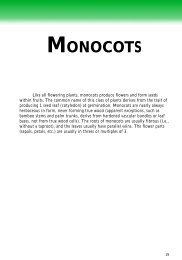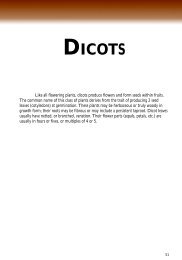2009 Invasive Plant List - Florida Exotic Pest Plant Council
2009 Invasive Plant List - Florida Exotic Pest Plant Council
2009 Invasive Plant List - Florida Exotic Pest Plant Council
Create successful ePaper yourself
Turn your PDF publications into a flip-book with our unique Google optimized e-Paper software.
<strong>Florida</strong> <strong>Exotic</strong> <strong>Pest</strong> <strong>Plant</strong> <strong>Council</strong>’s<strong>2009</strong> <strong>List</strong> of <strong>Invasive</strong> <strong>Plant</strong> SpeciesPurpose of the <strong>List</strong>: To focus attention on —4the adverse effects exotic pest plants have on <strong>Florida</strong>’s biodiversity and plant communities,4the habitat losses from exotic pest plant infestations,4the impacts on endangered species via habitat loss and alteration,4the need to prevent habitat losses through pest-plant management,4the socio-economic impacts of these plants (e.g., increased wildfires in certain areas),4changes in the seriousness of different pest plants over time,4the need to provide information that helps managers set priorities for control programs.CATEGORY I<strong>Invasive</strong> exotics that are altering native plant communities by displacing native species, changing community structuresor ecological functions, or hybridizing with natives. This definition does not rely on the economic severity or geographic rangeof the problem, but on the documented ecological damage caused.FLEPPC Gov. Reg.Scientific Name Common Name Cat. <strong>List</strong> Dist.Abrus precatorius rosary pea I N C, SAcacia auriculiformis earleaf acacia I C, SAlbizia julibrissin mimosa, silk tree I N, CAlbizia lebbeck woman’s tongue I C, SArdisia crenata (A. crenulata misapplied) coral ardisia I N, C, SArdisia elliptica (A. humilis misapplied) shoebutton ardisia I N C, SAsparagus aethiopicus (A. sprengeri; asparagus-fern I N, C, SA. densiflorus misapplied)Bauhinia variegata orchid tree I C, SBischofia javanica bishopwood I C, SCalophyllum antillanum santa maria (names “mast wood,” I S(C. calaba and C. inophyllum misapplied) “Alexandrian laurel” used in cultivation)Casuarina equisetifolia Australian-pine, beach sheoak I P, N N, C, SCasuarina glauca suckering Australian-pine, gray sheoak I P, N C, SCinnamomum camphora camphor tree I N, C, SColocasia esculenta wild taro I N, C, SColubrina asiatica lather leaf I N SCupaniopsis anacardioides carrotwood I N C, SDioscorea alata winged yam I N N, C, SDioscorea bulbifera air-potato I N N, C, SEichhornia crassipes water-hyacinth I P N, C, SEugenia uniflora Surinam cherry I C, SFicus microcarpa (F. nitida and laurel fig I C, SF. retusa var. nitida misapplied) 1Hydrilla verticillata hydrilla I P, U N, C, SHygrophila polysperma green hygro I P, U N, C, SHymenachne amplexicaulis West Indian marsh grass I C, SImperata cylindrica (I. brasiliensis misapplied) cogon grass I N, U N, C, SIpomoea aquatica water-spinach I P, U CJasminum dichotomum Gold Coast jasmine I C, SJasminum fluminense Brazilian jasmine I C, SLantana camara (= L. strigocamara) lantana, shrub verbena I N, C, SLigustrum lucidum glossy privet I N, CLigustrum sinense Chinese privet, hedge privet I N, C, SLonicera japonica Japanese honeysuckle I N, C, SLudwigia peruviana Peruvian primrosewillow I N, C, SLuziola subintegra Tropical American water grass I SLygodium japonicum Japanese climbing fern I N N, C, SLygodium microphyllum Old World climbing fern I N C, SFLEPPC <strong>List</strong>Definitions:<strong>Exotic</strong> – a species introducedto <strong>Florida</strong>, purposefully or accidentally,from a natural rangeoutside of <strong>Florida</strong>.Native – a species whosenatural range includes <strong>Florida</strong>.Naturalized exotic – an exoticthat sustains itself outside cultivation(it is still exotic; it hasnot “become” native).<strong>Invasive</strong> exotic – an exotic thatnot only has naturalized, but isexpanding on its own in <strong>Florida</strong>native plant communities.Abbreviations:Government <strong>List</strong> (Gov. <strong>List</strong>):P = Prohibited aquatic plantby the <strong>Florida</strong> Department ofAgriculture and ConsumerServices;N = Noxious weed listed by<strong>Florida</strong> Department of Agriculture& Consumer Services;U = Noxious weed listed byU.S. Department of Agriculture.Regional Distribution (Reg. Dist.):N = north, C = central,S = south, referring to eachspecies’ current distribution ingeneral regions of <strong>Florida</strong> (notits potential range in the state).Please refer to the map below.1Does not include Ficus microcarpa subsp. fuyuensis, which is sold as “Green Island Ficus”FLEPPC <strong>2009</strong> <strong>List</strong> of <strong>Invasive</strong> <strong>Plant</strong> Species – Fall <strong>2009</strong>
Changes tothe <strong>2009</strong> <strong>List</strong>:Luziola subintegra, added to list asCategory ILuziola subintegra (rice grass) wasfirst discovered in Lake Okeechobeeby Mike Bodle in 2007. This aquaticgrass is spreading in the lake. Itgrows in water 2-3 m deep, spreadsvegetatively and by seed, andaggressively outcompetes othernative and exotic species. To date,2,000 acres have been treated.Nymphoides cristata, moved fromCategory II to Category ISnowflake (Nymphoides cristata)is an Asian aquatic that becameproblematic in southwest <strong>Florida</strong> inthe 1990s. It is now an abundantweed in canals and ponds insouthwest <strong>Florida</strong>, and has spreadthroughout the peninsula where it hasbeen documented in seven counties,from Collier to St. Johns. It hascolonized the Big Cypress NationalPreserve where it is invading severalstrand swamps along Tamiami Trail,presumably introduced by fishermanusing cast nets infested from watersoutside of the preserve.Salvinia minima, added to list asCategory IWater spangles (Salvinia minima),first found in <strong>Florida</strong> in 1928,remained a cryptic species duringa period when opinions differed onits status as native or introducedin <strong>Florida</strong>. In 2001, a study of earlyherbarium voucher data revealed theintroduction points and systematicspread of this free-floating fern intoand throughout <strong>Florida</strong>. S. minimaoutcompetes more nutritive nativeduckweeds by overtopping theirthinner fronds, which float flat uponthe water surface.Scleria lacustris, moved fromCategory II to Category IWright’s nutrush (Scleria lacustris)is an annual tropical sedge that wasfirst collected in <strong>Florida</strong> in 1988. In<strong>Florida</strong>, its distribution extends tomore than 20 distinct natural areasin eight counties within four majordrainage regions of the central andsouthern peninsula. Its unique growthhabit obscures open water anddrastically alters the naturally sparseand upright structure of preexistingnative vegetation. Such dominationmay even displace native prey forthe endangered <strong>Florida</strong> snail kite, asight feeder inhabiting many locationswhere invasive colonization occurs.FLEPPC Gov. Reg.Scientific Name Common Name Cat. <strong>List</strong> Dist.Macfadyena unguis-cati cat’s claw vine I N, C, SManilkara zapota sapodilla I SMelaleuca quinquenervia melaleuca, paper bark I P, N, U C, SMelinis repens (= Rhynchelytrum repens) Natal grass I N, C, SMimosa pigra catclaw mimosa I P, N, U C, SNandina domestica nandina, heavenly bamboo I N, CNephrolepis cordifolia sword fern I N, C, SNephrolepis brownii (= N. multiflora) Asian sword fern I C, SNeyraudia reynaudiana Burma reed, cane grass I N SNymphoides cristata snowflake I C, SPaederia cruddasiana sewer vine, onion vine I N SPaederia foetida skunk vine I N N, C, SPanicum repens torpedo grass I N, C, SPennisetum purpureum Napier grass I N, C, SPistia stratiotes water-lettuce I P N, C, SPsidium cattleianum (= P. littorale) strawberry guava I C, SPsidium guajava guava I C, SPueraria montana var. lobata (= P. lobata) kudzu I N N, C, SRhodomyrtus tomentosa downy rose-myrtle I N C, SRhynchelytrum repens (See Melinis repens)Ruellia brittoniana 2 Mexican petunia I N, C, S(R. tweediana misapplied)Salvinia minima water spangles I N, C, SSapium sebiferum (= Triadica sebifera) popcorn tree, Chinese tallow tree I N N, C, SScaevola taccada scaevola, half-flower, beach naupaka I N C, S(= Scaevola sericea, S. frutescens)Schefflera actinophylla schefflera, Queensland umbrella tree I C, S(= Brassaia actinophylla)Schinus terebinthifolius Brazilian pepper I P, N N, C, SScleria lacustris Wright’s nutrush I C, SSenna pendula var. glabrata climbing cassia, Christmas cassia, I C, S(= Cassia coluteoides) Christmas sennaSolanum tampicense (= S. houstonii) wetland nightshade, aquatic soda apple I N, U C, SSolanum viarum tropical soda apple I N, U N, C, SSyngonium podophyllum arrowhead vine I N, C, SSyzygium cumini jambolan plum, Java plum I C, STectaria incisa incised halberd fern I SThespesia populnea seaside mahoe I C, STradescantia fluminensis small-leaf spiderwort I N, CUrochloa mutica (= Brachiaria mutica) Para grass I C, SCATEGORY II<strong>Invasive</strong> exotics that have increased in abundance or frequency but have not yet altered <strong>Florida</strong> plant communities to theextent shown by Category I species. These species may become ranked Category I, if ecological damage is demonstrated.FLEPPC Gov. Reg.Scientific Name Common Name Cat. <strong>List</strong> DistAdenanthera pavonina red sandalwood II SAgave sisalana sisal hemp II C, SAleurites fordii (= Vernicia fordii) tung oil tree II N, CAlstonia macrophylla devil tree II SAlternanthera philoxeroides alligator weed II P N, C, SAntigonon leptopus coral vine II N, C, SAristolochia littoralis calico flower II N, C, SAsystasia gangetica Ganges primrose II C, S2The <strong>Plant</strong> <strong>List</strong> Committee is uncertain as to the correct name for this species. <strong>Plant</strong>s cultivated in <strong>Florida</strong>, all representing the same invasive species,have in the past been referred to as Ruellia brittoniana, R. tweediana, R. caerulea, and R. simplex.FLEPPC <strong>2009</strong> <strong>List</strong> of <strong>Invasive</strong> <strong>Plant</strong> Species – Fall <strong>2009</strong>
FLEPPC Gov. Reg.Scientific Name Common Name Cat. <strong>List</strong> Dist. Callistemon viminalis, added to list asCategory IIBegonia cucullata wax begonia II N, C, SBottlebrush (Callistemon viminalis), aBlechum pyramidatum green shrimp plant, Browne’s blechum II N, C, Spopular landscape tree, is now invadingBroussonetia papyrifera paper mulberry II N, C, Sundisturbed short hydroperiod wetlandCallisia fragrans inch plant, spironema II C, Scommunities in Miami-Dade, Collier,Callistemon viminalis bottlebrush, weeping bottlebrush II Sand Martin Counties, including thosein Big Cypress National Preserve andCasuarina cunninghamiana river sheoak, Australian-pine II P C, SEverglades National Park.Cecropia palmata trumpet tree II SDactyloctenium aegyptium, added toCestrum diurnum day jessamine II C, Slist as Category IIChamaedorea seifrizii bamboo palm II SClematis terniflora Japanese clematis II N, CCryptostegia madagascariensis rubber vine II C, SCyperus involucratus umbrella plant II C, S(C. alternifolius misapplied)Cyperus prolifer dwarf papyrus II C, SDactyloctenium aegyptium Durban crowfootgrass II N, C, SDalbergia sissoo Indian rosewood, sissoo II C, SElaeagnus umbellata silverberry, autumn olive II NElaeagnus pungens silverthorn, thorny olive II N, CEpipremnum pinnatum cv. Aureum pothos II C, SFicus altissima false banyan, council tree II SFlacourtia indica governor’s plum II SHemarthria altissima limpo grass II C, SHibiscus tiliaceus (See Talipariti tiliaceum)Hyparrhenia rufa jaragua II N, C, SIpomoea carnea ssp. fistulosa (= I. fistulosa) shrub morning-glory II P C, SJasminum sambac Arabian jasmine II SKalanchoe pinnata life plant II C, SKoelreuteria elegans ssp. formosana flamegold tree II C, S(= K. formosana; K. paniculata misapplied)Leucaena leucocephala lead tree II N N, C, SLandoltia punctata (= Spirodela punctata) Spotted duckweed II N, C, SLimnophila sessiliflora Asian marshweed II P, U N, C, SLivistona chinensis Chinese fan palm II C, SMelia azedarach Chinaberry II N, C, SMelinis minutiflora Molassesgrass II C,SMerremia tuberosa wood-rose II SMurraya paniculata orange-jessamine II SMyriophyllum spicatum Eurasian water-milfoil II P N, C, SPanicum maximum (= Urochloa maxima, Guinea grass II N, C, SMegathyrsus maximus)Passiflora biflora two-flowered passion vine II SPennisetum setaceum green fountain grass II SPhoenix reclinata Senegal date palm II C, SPhyllostachys aurea golden bamboo II N, CPittosporum pentandrum Philippine pittosporum, Taiwanese cheesewood II SPteris vittata Chinese brake fern II N, C, SPtychosperma elegans solitaire palm II SRhoeo spathacea (see Tradescantia spathacea)Ricinus communis castor bean II N, C, SRotala rotundifolia roundleaf toothcup, dwarf Rotala II SSansevieria hyacinthoides bowstring hemp II C, SSesbania punicea purple sesban, rattlebox II N, C, SSolanum diphyllum two-leaf nightshade II N, C, SSolanum jamaicense Jamaica nightshade II CSolanum torvum susumber, turkey berry II N, U N, C, SDurban crowfootgrass (Dactylocteniumaegyptium) is an annual grass that isa widely distributed weed throughoutthe southeastern US. In <strong>Florida</strong>, thisspecies has been documented in 54counties. While it is primarily a weedof disturbed areas, it also invadesbeach dune communities in southern<strong>Florida</strong>, including those located withinEverglades and Dry Tortugas NationalParks. Dense growth of this speciesinterferes with ground nesting birds inDry Tortugas and competes with stateand federally listed plant species on themainland.Elaeagnus umbellata, added to list asCategory IIAutumn-olive (Elaeagnus umbellata)is an aggressive shrub capable ofreplacing entire native ecosystems,which it has done in numerous locationsin other states. There are three knownnative locations in the eastern <strong>Florida</strong>panhandle; two are local escapesfrom cultivation. The third is a mixtureof mature upland sand hill and pinecommunities where a wildlife plantinghas escaped. The entire 2,081 acre siteis infested. The infestation ranges from100% (12.5 acres), to 50% (49.9 acres),to 25% (38.3 acres), to 10% or less(1,683.4 acres).Hyparrhenia rufa, added to list asCategory IIJaragua (Hyparrhenia rufa) is an annualgrass that is known from 14 <strong>Florida</strong>counties. In Miami-Dade County ithas been found in intact habitat inat least 12 pine rockland fragments,outcompeting native plant species.Landoltia punctata, added to list asCategory IISpotted duckweed (Landoltia punctata)is a small floating aquatic plant that isnative to Australia and Southeast Asia.Since it was first found in Missouri inthe 1930s, it has spread to 22 statesand been documented in 36 <strong>Florida</strong>counties. It invades a wide rangeof undisturbed aquatic habitats andoutcompetes native species.Syzygium jambos, formerly Category II,removed from <strong>List</strong>The Committee has not been ableto locate data showing this speciesbehaves as a Category II invasive.FLEPPC <strong>2009</strong> <strong>List</strong> of <strong>Invasive</strong> <strong>Plant</strong> Species – Fall <strong>2009</strong>
Use of theFLEPPC <strong>List</strong>FLEPPC encourages use of the<strong>Invasive</strong> Species <strong>List</strong> for prioritizingand implementing managementefforts in natural areas, foreducating lay audiences aboutenvironmental issues, and forsupporting voluntary invasiveplant removal programs. When anon-native plant species is to berestricted in some way by law,FLEPPC encourages use of the<strong>List</strong> as a first step in identifyingspecies worth considering forparticular types of restriction.For more information on usingthe FLEPPC <strong>List</strong> of <strong>Invasive</strong> <strong>Plant</strong>Species, see Wildland WeedsSummer 2002 issue (Vol. 5, No.3), pp. 16-17, or http://www.fleppc.org/list/list.htmNOTE: Not all exoticplants brought into <strong>Florida</strong>become pest plants in natural areas.The FLEPPC <strong>List</strong> of <strong>Invasive</strong><strong>Plant</strong> Species represents onlyabout 10% of the nearly 1,400exotic species that have beenintroduced into <strong>Florida</strong> and havesubsequently established outsideof cultivation. Most escapedexotics usually present only minorproblems in highly disturbedareas (such as roadsides). Andthere are other exotics cultivatedin <strong>Florida</strong> that are “wellbehaved”— that is, they don’tescape cultivation at all.www.fleppc.orgFLEPPC Gov. Reg.Scientific Name Common Name Cat. <strong>List</strong> Dist.Sphagneticola trilobata (= Wedelia trilobata) wedelia II N, C, SStachytarpheta cayennensis (= S. urticifolia) nettle-leaf porterweed II SSyagrus romanzoffiana queen palm II C, S(= Arecastrum romanzoffianum)Talipariti tiliaceum (= Hibiscus tiliaceus) mahoe, sea hibiscus II C, STerminalia catappa tropical-almond II C, STerminalia muelleri Australian-almond II C, STradescantia spathacea oyster plant II S(= Rhoeo spathacea, Rhoeo discolor)Tribulus cistoides puncture vine, burr-nut II N, C, SUrena lobata Caesar’s weed II N, C, SVitex trifolia simple-leaf chaste tree II C, SWashingtonia robusta Washington fan palm II C, SWedelia (see Sphagneticola above)Wisteria sinensis Chinese wisteria II N, CXanthosoma sagittifolium malanga, elephant ear II N, C, SCitation example:FLEPPC. <strong>2009</strong>. <strong>List</strong> of <strong>Invasive</strong> <strong>Plant</strong> Species. <strong>Florida</strong> <strong>Exotic</strong> <strong>Pest</strong> <strong>Plant</strong> <strong>Council</strong>. Internet: http://www.fleppc.org/list/list.htm or Wildland Weeds Vol. 12(4): 13-16. Fall <strong>2009</strong>.The <strong>2009</strong> list was prepared by the FLEPPC <strong>Plant</strong> <strong>List</strong> Committee:Keith A. Bradley – Chair (2006-present), The Institute for Regional Conservation, 22601 SW 152 nd Ave., Miami, FL 33170,(305) 247-6547, bradley@regionalconservation.orgJanice A. Duquesnel, <strong>Florida</strong> Park Service, <strong>Florida</strong> Department of Environmental Protection, P.O. Box 1052, Islamorada, FL 33036 ,(305) 664-8455, Janice.Duquesnel@dep.state.fl.usDavid W. Hall, Private Consulting Botanist, 3666 NW 13 th Place, Gainesville, FL 32605, (352) 375-1370Roger L. Hammer, Miami-Dade Parks Department, Castellow Hammock Nature Center, 22301 S.W. 162 nd Ave., Miami, FL 33030,kaskazi44@comcast.netPatricia L. Howell, Broward County Parks, Environmental Section, 950 NW 38 th St., Oakland Park, FL 33309,(954) 357-8137, phowell@broward.orgColette C. Jacono, Department of Agronomy, Center for Aquatic & <strong>Invasive</strong> <strong>Plant</strong>s, IFAS, University of <strong>Florida</strong>, 7922 NW 71 st St.,Gainesville, FL 32653, (352) 392-6894, colettej@ufl.eduKenneth A. Langeland, Center for Aquatic and <strong>Invasive</strong> <strong>Plant</strong>s, IFAS, University of <strong>Florida</strong>, 7922 NW 71 st St., Gainesville, FL 32606,(352) 392-9614, gator8@ufl.eduChris Lockhart, <strong>Florida</strong> Natural Areas Inventory, c/o P.O. Box 243116, Boynton Beach, FL 33424-3116, (850) 509-6482,clockhart@fnai.orgGil Nelson, Gil Nelson Associates, 157 Leonard’s Dr., Thomasville, GA 31792, gil@gilnelson.comRobert W. Pemberton, <strong>Invasive</strong> <strong>Plant</strong>s Research Lab, U.S. Dept. of Agriculture, 3225 College Ave., Ft. Lauderdale, FL 33312,Robert.Pemberton@ars.usda.govJimi L. Sadle, Everglades National Park, 40001 State Road 9336, Homestead, FL 33034, (305) 242-7806, Jimi_Sadle@nps.govRobert W. Simons, 1122 SW 11 th Ave., Gainesville, FL 32601-7816Sandra M. Vardaman, Alachua County Forever Land Conservation Program, Alachua County Environmental Protection Dept.,201 SE 2 nd Ave., Suite 201, Gainesville, <strong>Florida</strong> 32601, (352) 264-6803, smvardaman@alachuacounty.usDaniel B. Ward, Department of Botany, University of <strong>Florida</strong>, 220 Bartram Hall, Gainesville, FL 32611Richard P. Wunderlin, Institute for Systematic Botany, Dept. of Biological Sciences, University of South <strong>Florida</strong>, Tampa, FL 33620,(813) 974-2359, rwunder@cas.usf.eduFLEPPC Database – The <strong>Florida</strong> <strong>Exotic</strong> <strong>Pest</strong> <strong>Plant</strong> Database contains over 75,000 sight records of infestations of FLEPPCCategory I and Category II species in <strong>Florida</strong> public lands and waters. 211 species are recorded. Nearly all of the recordsare from local, state, and federal parks and preserves; a few records document infestations in regularly disturbed publiclands such as highways or utility rights-of-way. Natural area managers and other veteran observers of <strong>Florida</strong>’s naturallandscapes submit these records, with many supported further by voucher specimens housed in local or regional herbariafor future reference and verification. New and updated observations can be submitted online at www.eddmaps.org/florida/.This database, along with other plant-data resources such as the University of South <strong>Florida</strong> Atlas of <strong>Florida</strong> Vascular<strong>Plant</strong>s at www.plantatlas.usf.edu, the <strong>Florida</strong> Natural Areas Inventory database at www.fnai.org, and The Institute forRegional Conservation Floristic Inventory of South <strong>Florida</strong> database at www.regionalconservation.org,provides important basic supporting information for the FLEPPC <strong>List</strong> of <strong>Invasive</strong> <strong>Plant</strong> Species.Images and/or distributional data of FLEPPC-listed species may be found at one or more of the following websites:University of South <strong>Florida</strong> Atlas of <strong>Florida</strong> Vascular <strong>Plant</strong>s, www.plantatlas.usf.edu; the University of <strong>Florida</strong> Herbariumcollection catalog, http://www.flmnh.ufl.edu/herbarium/cat/, and image gallery, http://www.flmnh.ufl.edu/herbarium/cat/imagesearch.asp; at Fairchild Tropical Botanic Garden’s Virtual Herbarium, www.virtualherbarium.org/vhportal.html,The Robert K. Godfrey Herbarium at <strong>Florida</strong> State University, http://herbarium.bio.fsu.edu/index.php; the University of<strong>Florida</strong>’s IFAS Center for Aquatic and <strong>Invasive</strong> <strong>Plant</strong>s, http://plants.ifas.ufl.edu, and the USDA PLANTS database, http://plants.usda.gov/. Please note that greater success and accuracy in searching for plant images is likely if you search byscientific name rather than a common name. Common names often vary in cultivation and across regions. For additionalinformation on plants included in this list, see related links and pages at www.fleppc.org.FLEPPC <strong>2009</strong> <strong>List</strong> of <strong>Invasive</strong> <strong>Plant</strong> Species – Fall <strong>2009</strong>



